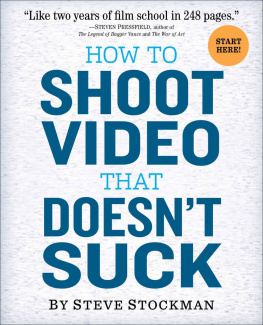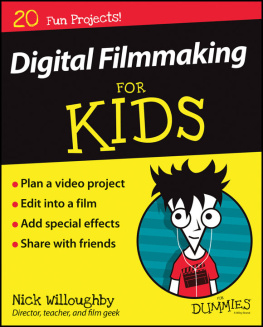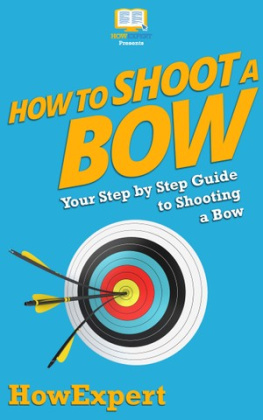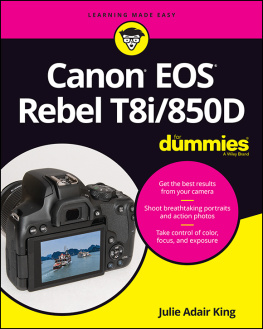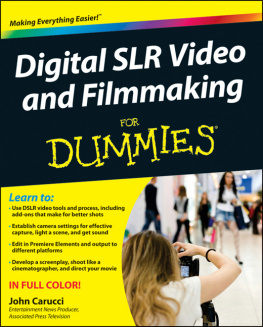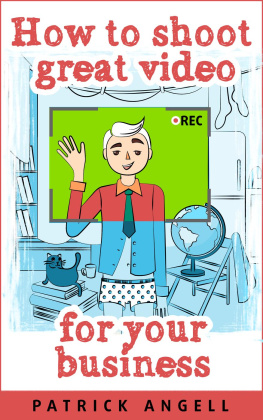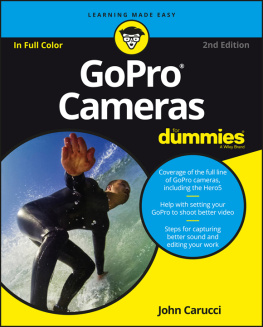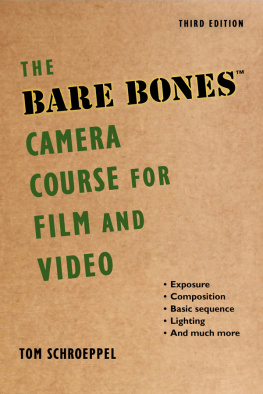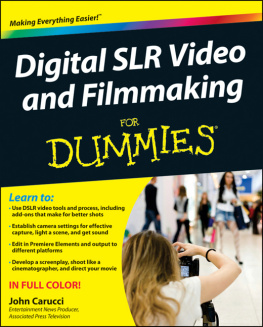HOW TO SHOOT VIDEO THAT DOESNT SUCK
BY STEVE STOCKMAN
Workman Publishing, New York
For Debbie, who by now probably deserves something more like a statue
Contents
PART 1
Think Like a Director
PART 2
PreparationThe Secret of the Pros
PART 3
Setting the Stage
PART 4
How to Shoot Video That Doesnt Suck
PART 5
Special Projects and How to Shoot Them
PART 6
After the Shoot
PART 7
Wrapping It Up
A Couple of Notes
About Video Equipment
This book isnt about equipment.
Video is like cooking: A good barbecue chicken recipe works on a $12 charcoal grill; a bad one tastes like crap even if you rotisserie it on a Viking. In video, you can shoot something great on your cell phone or something awful on a $100,000-a-day film set with a top-of-the-line Panavision package.
This book doesnt care what kind of camera you use, or how it connects to your computer, or how many ps there are in your HD. Its about your ingredients and how you put them together.
About Language
Since the dawn of home video, people have used film and video interchangeably, as in Im filming my mothers birthday party, when theyre actually using an HD video camera that records on chips rather than celluloid. Or Lets rent a video, when what they really rent is a DVD digital file of a two-hour theatrical feature shot on film.
Now, in the twenty-teens, its even more confusing. Many of the movies you see in the theater are shot on video then transferred to film to be projected. Your favorite TV show may be shot on film, digitized for postproduction, then output as files for digital broadcast. TV and movies are shot digitally and shown digitally. And many of the commercials you see were created entirely on a computerno film or video at all.
Given the practical pointlessness of the distinction, Im going to use film and video wherever they seem to fit and not worry too much about the technicalities. Neither should you.
INTRODUCTION
The Opposite of Good Is Off
Great video is a communication tool of unparalleled impact. It can change history, inspire movements, share and amplify emotions, and build community.
Bad video gets turned off.
Nobody watches bad video. Not your employees, even if you tell them to. Not your parents, even if you send them the cutest videos of your kids.
Faced with the choice of watching your terrible video or something good they can get with the touch of a button or mouse, no reasonable person will watch yoursunless youre standing over them going, Watch this. Youll love it! Then theyll grit their teeth and mumble, Oh. Yeah, this is great. But trust me, if youd sent them a link, theyd have been gone in under 20 seconds. Admit ityou would too.
Nobody watches bad video unless youre standing over them going, watch this!
Even mediocre video doesnt stand a chance, because we live in a world of great video. From Hollywood to Bollywood, pros crank out video thats technically perfect and reasonably entertaining. When you scan YouTube, the most-viewed videos are the best of more than one billion served by the site every day. The ones that float to the top of that enormous pile have to be pretty damn good.
Thats why the opposite of Good is Off.
If your videos not Good, its gone. And so is all your effort (and time and money). Like an unheard falling tree, it makes no soundexcept the sound of you whining that nobody watched your video. Which is why I suggest that the first and highest principle of creating video is to make one that doesnt suck. Like any Hollywood director worth her paycheck, your most important job is to entertain your audience.
But but but Yes, I can hear you gasping from here. But, you want to say, what about the ideas? What about training my employees? What about promoting my business? What about my daughters birthday party? Im making this video for a reason, not just to entertain!
If your videos not Good, its gone. And so is all your effort (and time and money). Like an unheard falling tree, it makes no soundexcept the sound of you whining.
Of course you are. Films are made out of passion for the story or the subject matter. We shoot our daughters birthday party because we love her and want a record of when she was young; we record a speech because were moved by the speaker; we create a Web video about stamps because its our passion; we put together a funny video about work to help build a stronger team; we shoot our friend who did the marathon in a wheelchair because we want to inspire; we interview our 100-year-old grandmother because we want to remember.
Those are the reasons we start a video project. But at some point, once begun, we have to consider our audience. They need to be intrigued, led, and taken care of. A poorly done video, one that bores people to the point of ejection, is worse than no video at all.
If your video doesnt get watched, you have no chance to inspire. No chance to inform, or build your team, or share your passion. In fact, you may uninspire people. Want proof? Check out a YouTube video thats been up for a while but has less than 100 views. They are, universally, horrible. They may have been born out of passion, but they were executed ineptly. Nobody will watch them except guilt-ridden family and friendsand maybe not even them. You dont want that to happen to you.
Luckily, stories about inspiration, success, nostalgia, humor, and passion are entertainingas long as you dont push your audience away by giving them video that sucks! Youre inspired. Thats a great start. To serve that inspiration, you have to tell your story well. You have to entertain.
Video as a Second Language
Video is the new language, and most of us are illiterate. Its not that we dont understand video. Weve spent years watching movies, television, and YouTube. We know how the camera angles should look and, at least unconsciously, what they mean. We know how the stories go, whether the guy and girl belong together, or when the monster will jump out.
We understand video better than any humans that have ever lived. Most of us just dont speak it very well.
Learning how to make really effective video is like learning to speak a second language: You have to learn not just what to say but how what you say will be received by others. When visiting France, you dont want to say something you think means Can you tell me what tonights dessert is? and find out you just asked the waiter why his clothes are so ugly.
In the language of video, camera angles and movement have meaning. You dont want to play back an interview with your 100-year-old great-aunt and discover that by hand-holding the camera and positioning her by the window so she was looking up at you past the lens, you made her look like a creepy, silhouetted serial killer.
Some people think that having great equipment will save them. And its true that todays cameras do more, better, than any video cameras in history. But like your computer, your video camera is a tool, not a storyteller. It only speaks video as well as you do.
Knowing how to work a video camera doesnt make you a filmmaker any more than knowing how to cut with a scalpel makes you a brain surgeon. As in the PowerPoint Revolution before itand the Desktop Publishing Revolution before thatgood equipment is helpful but not sufficient to create good output. Some people focus on the equipment, not what they do with it. Theyre so busy worrying about wires and pixels and computer software that they never think about how to make something an audience will want to watch.

